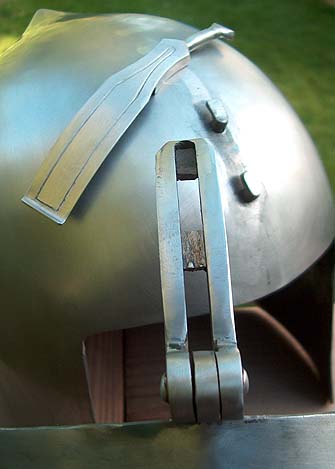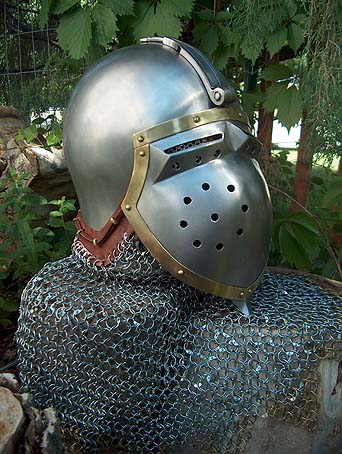| Author |
Message |
Adam R

Location: Vale of Belvoir, UK Joined: 15 Jan 2004
Posts: 39
|
 Posted: Thu 01 Jul, 2004 6:57 am Post subject: Klappvisier Posted: Thu 01 Jul, 2004 6:57 am Post subject: Klappvisier |
 |
|
 Hi Hi
Can anyone help? I need some detailed explanations / drawings of the klappvisier hinge and attachment mechanisms found on the German bascinets where the visor is attached by a single point at the centre top of the visor.
Thanks in advance
Adam
Adam Roylance
KDF Nottingham
www.nottinghamsword.co.uk
|
|
  |
 |
|
Steve Fabert
|
|
  |
 |
|
Christian Fletcher
Industry Professional
|
 Posted: Thu 01 Jul, 2004 7:30 am Post subject: Posted: Thu 01 Jul, 2004 7:30 am Post subject: |
 |
|
If you're willing to trust my interpretation of one of these, here's a photo...
 Attachment: 20.83 KB Attachment: 20.83 KB

Christian Fletcher
www.christianfletcher.com
|
|
   |
 |
Adam R

Location: Vale of Belvoir, UK Joined: 15 Jan 2004
Posts: 39
|
 Posted: Thu 01 Jul, 2004 2:48 pm Post subject: Thanks! Posted: Thu 01 Jul, 2004 2:48 pm Post subject: Thanks! |
 |
|

Thanks Steve and thanks Christian. Very useful indeed!
Christian...when the pivot plate is down, does it lock the visor in a closed position?
Adam Roylance
KDF Nottingham
www.nottinghamsword.co.uk
|
|
  |
 |
|
Christian Fletcher
Industry Professional
|
 Posted: Thu 01 Jul, 2004 3:14 pm Post subject: Posted: Thu 01 Jul, 2004 3:14 pm Post subject: |
 |
|
No, the only thing this mechanism does is lock the visor's hinge to the front of the helmet. The visor itself is still free to open and, as far as I can tell, would not have had any provision for securing it shut.
 Attachment: 59.6 KB Attachment: 59.6 KB

Christian Fletcher
www.christianfletcher.com
|
|
   |
 |
Adam R

Location: Vale of Belvoir, UK Joined: 15 Jan 2004
Posts: 39
|
 Posted: Fri 02 Jul, 2004 4:48 am Post subject: and again.. Posted: Fri 02 Jul, 2004 4:48 am Post subject: and again.. |
 |
|
Thanks again Christian.
If you located the axis of the pin off centre, towards the rear of the hinge, the swivel plate could be located to lock the visor down. What do you think? Worthwhile or not? My only puzzlement is what happens to the visor when fighting, it looks like it will flap about. If it is the stiffness of the hinge that keeps it down then that would need to have the pin replaced from time to time and (worse still) the visor could concievably get openned in the fray and would then stay open... a whole new hooking target for the bloke with a poll arm! 
Adam Roylance
KDF Nottingham
www.nottinghamsword.co.uk
|
|
  |
 |
|
Steve Fabert
|
 Posted: Fri 02 Jul, 2004 6:04 am Post subject: Posted: Fri 02 Jul, 2004 6:04 am Post subject: |
 |
|
My impression has always been that this style of visor was intended to be used "on or off" rather than "up or down". The upper pin allowed the visor to be removed entirely when the user wanted open vision and breathing, and it was intended to remain in the down position while it was pinned to the helm.
The potential problems of lifting the visor either intentionally or accidentally during combat would appear to have been the same whether it was mounted on a center hinge or two side pivots. Stiff hinges were the only obvious method of keeping the visor in the desired position. Only a detailed examination of the museum pieces would confirm whether there were any attempts made to use additional hardware to secure the lower end of the visor to the sides of the bascinet. The Czech model I listed above seems to have solved the problem by adding a side hook that I have not seen on originals.
|
|
  |
 |
Adam R

Location: Vale of Belvoir, UK Joined: 15 Jan 2004
Posts: 39
|
 Posted: Fri 02 Jul, 2004 7:41 am Post subject: Posted: Fri 02 Jul, 2004 7:41 am Post subject: |
 |
|
| Steve Fabert wrote: | My impression has always been that this style of visor was intended to be used "on or off" rather than "up or down". The upper pin allowed the visor to be removed entirely when the user wanted open vision and breathing, and it was intended to remain in the down position while it was pinned to the helm.
The potential problems of lifting the visor either intentionally or accidentally during combat would appear to have been the same whether it was mounted on a center hinge or two side pivots. Stiff hinges were the only obvious method of keeping the visor in the desired position. Only a detailed examination of the museum pieces would confirm whether there were any attempts made to use additional hardware to secure the lower end of the visor to the sides of the bascinet. The Czech model I listed above seems to have solved the problem by adding a side hook that I have not seen on originals. |
Hmmm, perhaps, but why the big hinge then? you could make a more easily detachable visor without the one (or ven two on that style) hinge present. The whole arrangement looks rather overkill for just a fixing point. I am going to the Armouries in the next week or so, I'll try and have a butchers.
Adam Roylance
KDF Nottingham
www.nottinghamsword.co.uk
|
|
  |
 |
|
Christian Fletcher
Industry Professional
|
 Posted: Fri 02 Jul, 2004 9:29 am Post subject: Posted: Fri 02 Jul, 2004 9:29 am Post subject: |
 |
|
This has been an interesting point of speculation for me as well as others. Hinging makes sense, as you would want to be able to see and breath freely most of the time by leaving the visor up and dropping it at a moment's notice when needed. Unlike later period visors, however, this style can be quickly removed all together. Was this visor intended to be removed and discarded in the course of battle?
Christian Fletcher
www.christianfletcher.com
|
|
   |
 |
|
Steve Fabert
|
 Posted: Fri 02 Jul, 2004 9:59 am Post subject: Posted: Fri 02 Jul, 2004 9:59 am Post subject: |
 |
|
|
The central hinge apparently was a temporary solution that appeared in a limited geographical area. In England and France the side hinges were used much more often than the central single hinge, which is usually referred to as a German design. My guess would be that the central hinge was not very satisfactory, however the individual knight preferred to use the visor. It is always possible that it was intended primarily for mounted use against opponents with lances. The same helm may have been worn without the visor during foot combat. I don't recall offhand seeing any artwork that shows a knight with the visor lifted during a battle.
|
|
  |
 |
|
|

